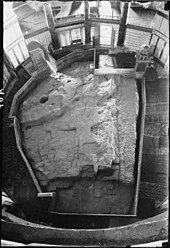
Omphalos
An omphalos is a religious stone artefact. In Ancient Greek, the word ὀμφᾰλός (omphalós) means "navel". Among the Ancient Greeks, it was a widespread belief that Delphi was the center of the world. According to the myths regarding the founding of the Delphic Oracle, Zeus, in his attempt to locate the center of the earth, launched two eagles from the two ends of the world, and the eagles, starting simultaneously and flying at equal speed, crossed their paths above the area of Delphi, and so was the place where Zeus placed the stone.
Omphalos is also the name of the stone given to Cronus. In the ancient world of the Mediterranean, it was a powerful religious symbol.
Omphalos Syndrome refers to the belief that a place of geopolitical power and currency is the most important place in the world.
Delphi
Most accounts locate the Delphi omphalos in the adyton (sacred part of the temple) near the Pythia (oracle). The stone sculpture itself, which may be a copy, has a carving of a knotted net covering its surface and a hollow center, widening towards the base. The omphalos represents the stone which Rhea wrapped in swaddling clothes, pretending it was Zeus, in order to deceive Cronus. (Cronus was the father who swallowed his children so as to prevent them from usurping him as he had deposed his own father, Uranus.)
Omphalos stones were believed to allow direct communication with the gods. Holland (1933) suggested that the stone was hollow to allow intoxicating vapours breathed by the Oracle to channel through it. Erwin Rohde wrote that the Python at Delphi was an earth spirit, who was conquered by Apollo and buried under the Omphalos. However, understanding of the use of the omphalos is uncertain due to destruction of the site by Theodosius I and Arcadius in the 4th century CE.
Jerusalem
Judaism
The Foundation Stone at the peak of the Temple Mount is considered in traditional Jewish sources to be the place from which the creation of the world began, with several further major biblical events connected to it. Jewish tradition holds that God revealed Himself to His people through the Ark of the Covenant in the Temple in Jerusalem, which rested on the Foundation Stone marking the centre of the world.
Christianity

The omphalos at the Church of the Holy Sepulchre, Jerusalem, represents, in medieval Christian tradition, the navel of the world (the spiritual and cosmological centre of the world). The omphalos stone has a collection box chained next to it (see picture).
Islam
The Dome of the Rock on the Aqsa Masjid/Haram ash-Sharif might have served the same purpose in Islam.
Art
Omphalos is a public art sculpture by Dimitri Hadzi formerly located in the Harvard Square, Cambridge, Massachusetts under the Arts on the Line program. As of 2014, the sculpture has been deinstalled; it will be relocated to Rockport, Massachusetts.
Omfalos is a concrete and rock sculpture by the conceptual artist Lars Vilks, previously standing in the Kullaberg natural reserve, Skåne County, Sweden. As of 2001, the sculpture belongs to the collections of Moderna Museet in Stockholm, Sweden.
Literature
In literature, the word omphalos has held various meanings but usually refers to the stone at Delphi. Authors who have used the term include: Homer,Pausanias, D.H. Lawrence, James Joyce, Philip K. Dick, Jacques Derrida, Ted Chiang and Sandy Hingston. For example, Joyce uses the term in the novel, Ulysses:
"Billy Pitt had them built," Buck Mulligan said, "when the French were on the sea but our's is the omphalos." [Chapter 1]
One of her sisterhood lugged me squealing into life. Creation from nothing. What has she in the bag? A misbirth with a trailing navelcord, hushed in ruddy wool. The cords of all link back, strandentwining cable of all flesh. That is why mystic monks. Will you be as gods? Gaze in your omphalos. [Chapter 3]
[...] to set up there a national fertilising farm to be named Omphalos with an obelisk hewn and erected after the fashion of Egypt and to offer his dutiful yeoman services for the fecundation of any female of what grade of life soever who should there direct to him with the desire of fulfilling the functions of her natural. [Chapter 14]
In Ted Chiang's short story "Omphalos" (2019), the protagonist is forced to question her belief about where the center of the world is located.
See also
- Axis mundi
- Benben stone
- Black Stone
- Kaaba
- Lapis Niger
- Name of Mexico
- Lia Fáil
- Lingam
- Stone of Scone
- Umbilicus urbis Romae
Sources
- Burkert, Walter (1985). Greek Religion.
- Dehoqu (1925). Dishi.
- Farnell, Lewis R. (1896). The Cults of the Greek States.
- Goodrich, Norma L. (1990). Priestesses. ISBN 9780531151136.
- Guthrie, W.K.C. (1955). The Greeks and their Gods. ISBN 9780807057933.
- Hall, Manly P. (1928). "The Secret Teachings of All Ages: Greek Oracles". Sacred texts.
- Harrison, Jane Ellen (1912). "Themis: A Study of the Social Origins of Greek Religion". p. 396.
- Holland, Leicester B. (1933). "The Mantic Mechanism at Delphi". American Journal of Archaeology. 37 (14): 204–214. doi:10.2307/498438. JSTOR 498438. S2CID 191389544.
- "Homeric Hymn to Pythian Apollo". The Medieval and Classical Literature Library.
-
Oswald, Pierre Jean & Kitsikis, Dimitri (1977). Omphalos. Paris.
{{cite book}}: CS1 maint: multiple names: authors list (link) - Rohde, Erwin (1925). Psyche.
- Shafer, Joseph R. (2011). Literary Identity in the Omphalos Periplus.
- Trubshaw, Bob (February 1993). "The Black Stone - the Omphalos of the Goddess". Mercian Mysteries. Vol. 14.


